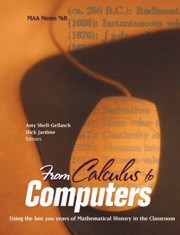Book contents
- Frontmatter
- Preface
- Contents
- Introduction
- I Algebra, Number Theory, Calculus, and Dynamical Systems
- 1 Arthur Cayley and the First Paper on Group Theory
- 2 Putting the Differential Back Into Differential Calculus
- 3 Using Galois' Ideas in the Teaching of Abstract Algebra
- 4 Teaching Elliptic Curves Using Original Sources
- 5 Using the Historical Development of Predator-Prey Models to Teach Mathematical Modeling
- II Geometry
- III Discrete Mathematics, Computer Science, Numerical Methods, Logic, and Statistics
- IV History of Mathematics and Pedagogy
- About the Authors
4 - Teaching Elliptic Curves Using Original Sources
from I - Algebra, Number Theory, Calculus, and Dynamical Systems
- Frontmatter
- Preface
- Contents
- Introduction
- I Algebra, Number Theory, Calculus, and Dynamical Systems
- 1 Arthur Cayley and the First Paper on Group Theory
- 2 Putting the Differential Back Into Differential Calculus
- 3 Using Galois' Ideas in the Teaching of Abstract Algebra
- 4 Teaching Elliptic Curves Using Original Sources
- 5 Using the Historical Development of Predator-Prey Models to Teach Mathematical Modeling
- II Geometry
- III Discrete Mathematics, Computer Science, Numerical Methods, Logic, and Statistics
- IV History of Mathematics and Pedagogy
- About the Authors
Summary
Introduction
In this paper we give an overview of the subject of elliptic curves and examine some of the original sources that can be used to teach this very important topic in a history of mathematics course. Portions of this material are also appropriate for courses in abstract algebra, number theory, or geometry.
There are two purposes for introducing students to elliptic curves. First, the topic of elliptic curves is a beautiful one combining significant ideas from algebra, geometry, number theory, and analysis; the elements of this topic can be understood by the undergraduate mathematics major. Second, this topic gives students an exposure to mathematics with a rich history, that is still an active area of research. As L.J. Mordell writes, the subject of elliptic curves is fascinating “not only because of the simplicity of enunciation, but also because it appeals to the natural curiosity of persons who have anything at all to do with numbers” [31, p. 41]
The subject of elliptic curves is both ancient and very modern. The roots of the subject lie in the work of Diophantus, and Diophantine problems remain to this day a primary source for research in elliptic curves. Fermat's Last Theorem is a well-known example of a Diophantine problem and elliptic curves played a central role in its proof. Andrew Wiles' proof is beyond the scope of the present paper, but the text by Hellegouarch [17] has an excellent discussion of the mathematical background needed for the proof.
- Type
- Chapter
- Information
- From Calculus to ComputersUsing the Last 200 Years of Mathematics History in the Classroom, pp. 25 - 44Publisher: Mathematical Association of AmericaPrint publication year: 2005

